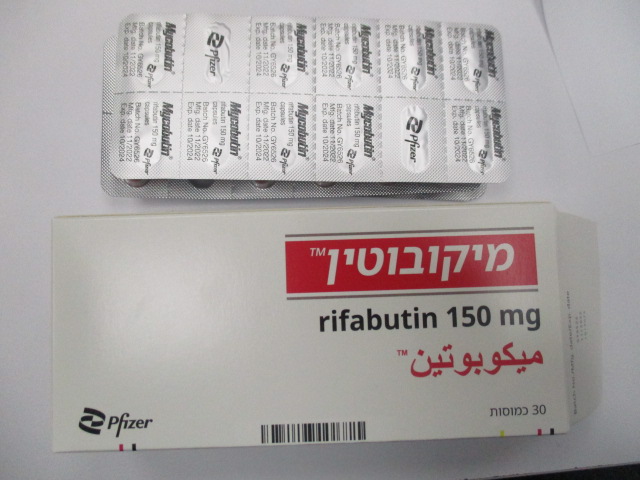Quest for the right Drug

מיקובוטין MYCOBUTIN (RIFABUTIN)
תרופה במרשם
תרופה בסל
נרקוטיקה
ציטוטוקסיקה
צורת מתן:
פומי : PER OS
צורת מינון:
קפסולות : CAPSULES
עלון לרופא
מינוניםPosology התוויות
Indications תופעות לוואי
Adverse reactions התוויות נגד
Contraindications אינטראקציות
Interactions מינון יתר
Overdose הריון/הנקה
Pregnancy & Lactation אוכלוסיות מיוחדות
Special populations תכונות פרמקולוגיות
Pharmacological properties מידע רוקחי
Pharmaceutical particulars אזהרת שימוש
Special Warning עלון לרופא
Physicians Leaflet
Special Warning : אזהרת שימוש
4.4. Special warnings and precautions for use Before starting Mycobutin prophylaxis, patients should be assessed to ensure that they do not have active disease caused by pulmonary tuberculosis or other mycobacteria. Prophylaxis against MAC infection may need to be continued throughout the patient's lifetime. Mycobutin may impart a red-orange colour to the urine and possibly to skin and body secretions. Contact lenses, especially soft, may be permanently stained. Mild hepatic impairment does not require a dose modification. Mycobutin should be used with caution in cases of severe liver insufficiency. Mild to moderate renal impairment does not require any dosage adjustment. Severe renal impairment (creatinine clearance below 30 ml/min) requires a dosage reduction of 50%. It is recommended that white blood cell and platelet counts and liver enzymes be monitored periodically during treatment. When Mycobutin is used concomitantly with clarithromycin for MAC treatment, a decreased dose of Mycobutin is recommended due to the increase in plasma concentrations of Mycobutin (See Section 4.2 Posology & Method of Administration, and Section 4.5 Interactions with other Medications & Other Forms of Interactions). Because of the possibility of occurrence of uveitis, patients should be carefully monitored when rifabutin is given in combination with clarithromycin (or other macrolides) and/or fluconazole (and related compounds). If such an event occurs, the patient should be referred to an ophthalmologist and, if considered necessary, Mycobutin treatment should be suspended. Uveitis associated with Mycobutin must be distinguished from other ocular complications of HIV. HIV protease inhibitors act as substrates or inhibitors of CYP450 3A4 mediated metabolism. Therefore, due to significant drug-drug interactions between protease inhibitors and rifabutin, their concomitant use should be based on the overall assessment of the patient and patient specific drug profile (see section 4.5). Rifabutin is a CYP450 3A inducer. Therefore, co-administration with antiretroviral medicines including but not limited to bictegravir, elvitegravir, oral rilpivirine, or doravirine and anti-HCV medicines including but not limited to sofosbuvir (alone or in combination) is not recommended due to the expected decrease in plasma concentrations of the antiretrovirals and anti-HCV medicines which may lead to loss of virologic response and possible development of resistance (see section 4.5). For further recommendations, please refer to the most recent prescribing information of the antiretrovirals or contact the specific manufacturer. Clostridium difficile associated diarrhoea (CDAD) has been reported with use of nearly all antibacterial agents, including rifabutin, and may range in severity from mild diarrhoea to fatal colitis. Treatment with antibacterial agents alters the normal flora of the colon leading to overgrowth of C. difficile. C. difficile produces toxins A and B which contribute to the development of CDAD. Hypertoxin producing strains of C. difficile cause increased morbidity and mortality, as these infections can be refractory to antimicrobial therapy and may require colectomy. CDAD must be considered in all patients who present with diarrhoea following antibiotic use. Careful medical history is necessary since CDAD has been reported to occur over two months after the administration of antibacterial agents. There have been reports of severe cutaneous adverse reactions (SCARs), such as Stevens-Johnson syndrome (SJS), toxic epidermal necrolysis (TEN), drug reaction with eosinophilia and systemic symptoms (DRESS), and acute generalized exanthematous pustulosis (AGEP) with anti-tuberculosis drugs (see section 4.8). If patients develop a skin rash they should be monitored closely and suspect drug(s) discontinued if lesions progress. Identifying the specific drug is difficult, as multiple anti-tuberculosis drugs are prescribed in association concurrently. Specifically, for DRESS, a multi-system potential life-threatening SCAR, time to onset of the first symptoms may be prolonged. DRESS is a clinical diagnosis, and its clinical presentation remains the basis for decision making. An early withdrawal of the suspect drug is essential because of the syndrome’s mortality and visceral involvement (e.g., liver, bone marrow or kidney). Excipients: Mycobutin contains less than 1 mmol sodium (23 mg) per capsule, that is to say essentially ‘sodium-free’.
Effects on Driving

שימוש לפי פנקס קופ''ח כללית 1994
לא צוין
תאריך הכללה מקורי בסל
01/03/2002
הגבלות
תרופה מוגבלת לרישום ע'י רופא מומחה או הגבלה אחרת
מידע נוסף
עלון מידע לצרכן
09.08.22 - עלון לצרכן אנגלית 09.08.22 - עלון לצרכן עברית 09.08.22 - עלון לצרכן ערבית 03.07.23 - עלון לצרכן עברית 17.07.23 - עלון לצרכן אנגלית 17.07.23 - עלון לצרכן ערבית 28.12.23 - עלון לצרכן עברית 08.02.24 - עלון לצרכן אנגלית 08.02.24 - עלון לצרכן ערבית 06.03.16 - החמרה לעלון 28.02.17 - החמרה לעלון 25.04.22 - החמרה לעלון 03.07.23 - החמרה לעלון 29.12.23 - החמרה לעלון 09.04.24 - החמרה לעלוןלתרופה במאגר משרד הבריאות
מיקובוטין